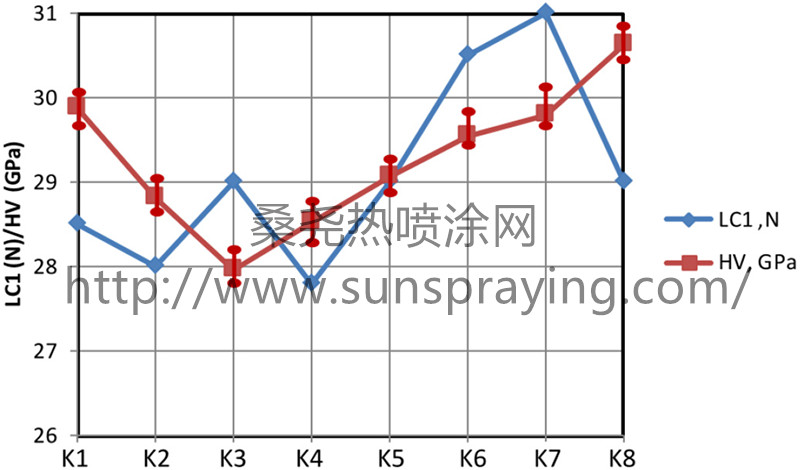In particular, nanocrystals, nanostructured coatings with a nanolayer thickness of<100 nm, are becoming more widely used as modifying coatings for metal cutting tools . A number of studies have shown that the nanostructured coatings have certain advantages compared to monolithic coatings of the traditional type. In particular, the studies have noted better barrier functions of nanostructured coatings with respect to diffusion processes and heat flows. An important feature of the nanostructured coatings is their higher crack and impact resistance. An important parameter of the nanostructured coatings is the nanolayer thickness. However, the challenge of choosing the optimal thickness of nanolayers has not often been considered in technical studies. Only a small number of studies exist on the issue. Meanwhile, the challenge of choosing the optimal thickness of nanolayers is very important for developing an algorithm for choosing a nanostructured coating with optimal properties. Thus, the CrVN/TiN coating with the binary period of λ = 15, 30, and 43 nm was considered in. It was found that λ does not have a significant effect on the hardness and elasticity modulus of the coating, and its reduction increases the strength of the adhesive bond with the substrate and the wear resistance and decreases the friction coefficient. The studies revealed changes in the patterns of wear for samples with the coatings under study, depending on the value of λ. The molecular adhesion prevailed in the samples with a lower λ, whereas the oxidation processes played a larger role with an increasing λ. The mechanism of plastic deformation of the CrN/AlN coating with the binary period of λ = 13 nm was considered in. It was found that the plastic yield in the coating under study is not related to the classical dislocation displacement but occurs due to the rotation of the grains in nanocrystals and the gliding along the boundaries for large grains. The TiAlCN/VCN nanostructured coating with λ = 2.2 nm was considered in. A single-phase of an NaCl fcc unit cell structure type with a {220} preferred orientation was found in the coating structure. The coating was characterised by a low friction coefficient, high hardness, and small residual stresses, and it showed high-performance properties in turning and drilling. During the investigation into the properties of the CrN/ZrN nanocomposite coating with λ = 11.7–66.7 nm , the CrN and ZrN nanocrystal layers with columnar structures were preserved in the coating structure without forming a superlattice structure. The hardness of the coating did not depend on the value of λ. When λ decreased, the friction coefficient fell, and the wear resistance increased. Whereas the orientation (200) prevailed in the CrN monolayered coating, in the case of the nanostructured coating, the orientation changed to (111) in the CrN nanolayer. In the course of the studies of the CrN/NbN nanolayer coating with λ = 20, 10, 7.5, and 4 nm, when λ < 10 nm, the lattice of each component could be coherently deformed, and only one intermediate lattice was found for the CrN/NbN multilayered structure. A decrease in λ led to an increase in hardness, a reduction in the friction coefficient, and an increase in the resistance to cohesive failure due to the predominance in the coating of a strong texture (200) at λ < 10 nm. Further simulation of the process to load the given CrN/ NbN coating with the finite-element method showed that, as λ decreased, the internal stresses at the interlayer boundaries increased. The authors of the study explain the above fact by the possible interaction of dislocations with the stress fields arising near the NbN-CrN boundary. The paper presents the results of the investigation into the formation of the nanolayer structure of the Ti-TiN- (Ti,Cr,Al)N coating and its influence on the thickness of coatings, their resistance to fracture in scratch testing, and the wear resistance of coated tools in turning 1045 steel. The structure of the coatings with the nanolayer thicknesses of 302, 160, 70, 53, 38, 24, 16, and 10 nm was studied using scanning electron microscopy (SEM), transmission electron microscopy (TEM), and high-resolution (HR) TEM. It is shown that the grain sizes in the nanolayers decrease to certain values with an increase in the thickness of the nanolayers, and then, with a further decrease in the nanolayer thickness, the grain sizes of the nanolayer grow as the interlayer interfaces cease to produce a restraining effect on the growth of the grains. The study found that the nanolayer thickness influenced the wear of carbide cutting tools and the pattern of fracture for the Ti-TiN-(Ti,Cr,Al)N coatings.

本文由桑尧热喷涂网收集整理。本站文章未经允许不得转载;如欲转载请注明出处,北京桑尧科技开发有限公司网址:http://www.sunspraying.com/
|

